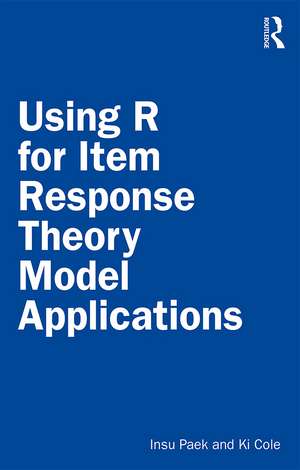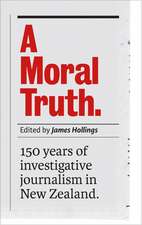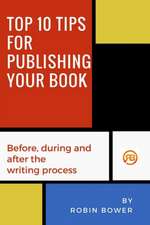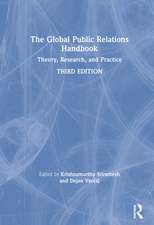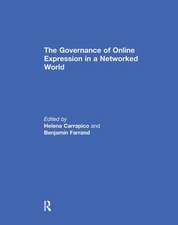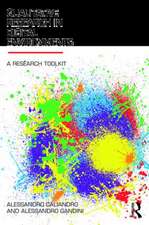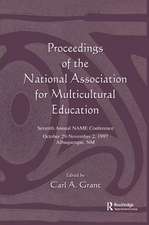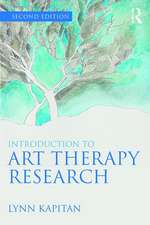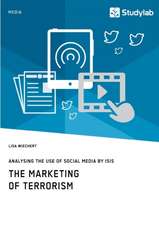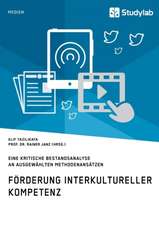Using R for Item Response Theory Model Applications
Autor Insu Paek, Ki Coleen Limba Engleză Hardback – 10 sep 2019
This book provides practical line-by-line descriptions of how to use R IRT packages for various IRT models. The scope and coverage of the modeling in the book covers almost all models used in practice and in popular research, including:
- dichotomous response modeling
- polytomous response modeling
- mixed format data modeling
- concurrent multiple group modeling
- fixed item parameter calibration
- modelling with latent regression to include person-level covariate(s)
- simple structure, or between-item, multidimensional modeling
- cross-loading, or within-item, multidimensional modeling
- high-dimensional modeling
- bifactor modeling
- testlet modeling
- two-tier modeling
| Toate formatele și edițiile | Preț | Express |
|---|---|---|
| Paperback (1) | 418.54 lei 6-8 săpt. | |
| Taylor & Francis – 10 sep 2019 | 418.54 lei 6-8 săpt. | |
| Hardback (1) | 1003.16 lei 6-8 săpt. | |
| Taylor & Francis – 10 sep 2019 | 1003.16 lei 6-8 săpt. |
Preț: 1003.16 lei
Preț vechi: 1223.37 lei
-18% Nou
Puncte Express: 1505
Preț estimativ în valută:
191.98€ • 199.69$ • 158.49£
191.98€ • 199.69$ • 158.49£
Carte tipărită la comandă
Livrare economică 14-28 aprilie
Preluare comenzi: 021 569.72.76
Specificații
ISBN-13: 9781138542785
ISBN-10: 1138542784
Pagini: 280
Ilustrații: 19 Line drawings, black and white; 2 Halftones, black and white; 21 Illustrations, black and white
Dimensiuni: 156 x 234 x 18 mm
Greutate: 0.54 kg
Ediția:1
Editura: Taylor & Francis
Colecția Routledge
Locul publicării:Oxford, United Kingdom
ISBN-10: 1138542784
Pagini: 280
Ilustrații: 19 Line drawings, black and white; 2 Halftones, black and white; 21 Illustrations, black and white
Dimensiuni: 156 x 234 x 18 mm
Greutate: 0.54 kg
Ediția:1
Editura: Taylor & Francis
Colecția Routledge
Locul publicării:Oxford, United Kingdom
Public țintă
Postgraduate and ProfessionalCuprins
Preface
1. Introduction
2. Unidimensional IRT with Dichotomous Item Responses
3. Unidimensional IRT with Polytomous Item Responses
4. Unidimensional IRT for Other Applications
5. Multidimensional IRT for Simple Structure
6. Multidimensional IRT for Bifactor Structure
7. Limitations and Caveat
1. Introduction
2. Unidimensional IRT with Dichotomous Item Responses
3. Unidimensional IRT with Polytomous Item Responses
4. Unidimensional IRT for Other Applications
5. Multidimensional IRT for Simple Structure
6. Multidimensional IRT for Bifactor Structure
7. Limitations and Caveat
Notă biografică
Insu Paek is an associate professor at Florida State University. Before he came to Florida State University, he worked as a psychometrician for large-scale assessment programs and in testing companies for several years. His research interests are educational and psychological measurement and item response modeling and its application.
Ki Cole is an assistant professor at Oklahoma State University. She teaches graduate level educational statistics courses, including item response theory and factor analysis for the behavioural sciences. Her research interests include the theory and applications of psychometrics, scale development, understanding response tendencies, and software evaluation.
Ki Cole is an assistant professor at Oklahoma State University. She teaches graduate level educational statistics courses, including item response theory and factor analysis for the behavioural sciences. Her research interests include the theory and applications of psychometrics, scale development, understanding response tendencies, and software evaluation.
Recenzii
This book is a great introduction to both the R program for item response theory (IRT) analysis and IRT modeling itself for readers who want a firm grasp on both skills. This book is a helpful manual for understanding IRT concepts and background concisely and for easily learning the freely accessible R programs for doing IRT analyses. Reading this book is like catching two birds with one stone. This book is clearly written and amazingly easy to follow from installing the R program and executing the R command to interpreting the executed results. This book also provides practical advice, guidance, and specific details on utilizing the R program for practitioners, researchers, and graduate students in an introductory or an intermediate IRT course. The authors explain the essential background of various IRT models and the logic of each model in terms of practical applications. A major strength of the book is its consistent use of detailed examples to illustrate the concepts, the practical applications of IRT, and the thorough explanation of results for the executed examples. Another strong point is the general approachability and clarity of the text. Both practical users of IRT and beginners of the R program will benefit from this clear text and detailed examples. As a practitioner who frequently uses IRT but has little experience with R for IRT analysis, I strongly recommend this book as a learning tool for both IRT and R IRT programs.Dr. Hyeonjoo Oh, Senior psychometrician, Educational Testing Service
Descriere
This book introduces basic concepts of IRT and detailed information on how to use R IRT programs for IRT applications.
